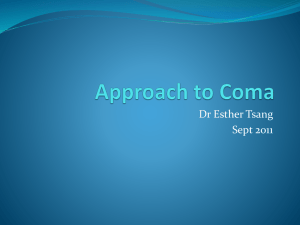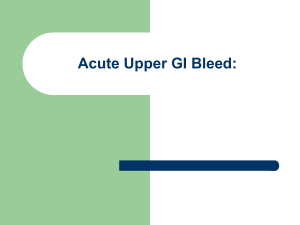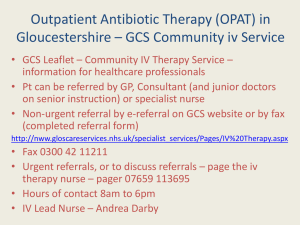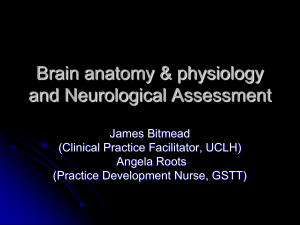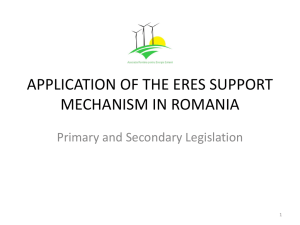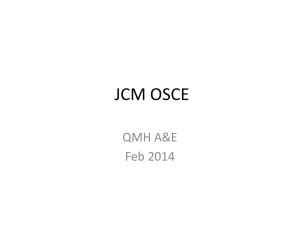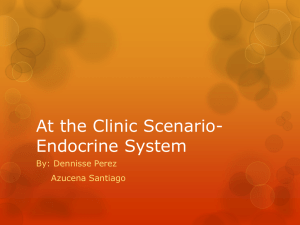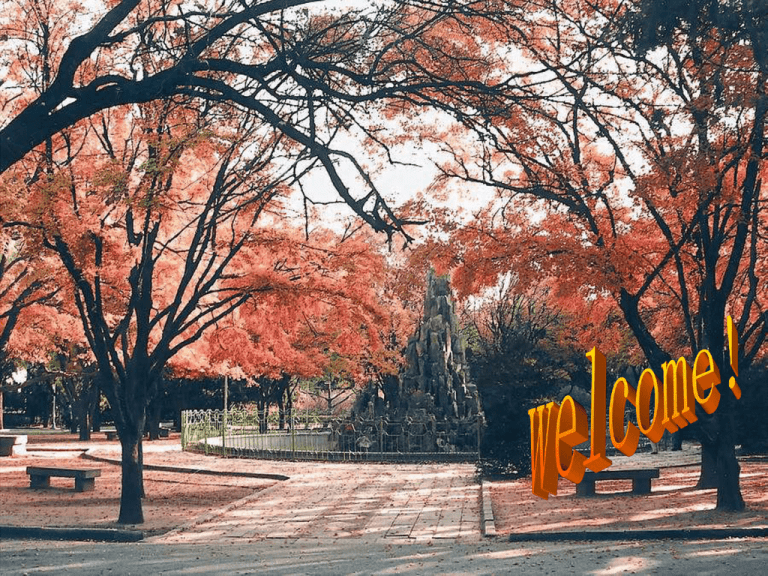
Agents used in endocrine
system
Some endocrine hormones
and relative drugs
1.adrenocorticoids
2.Posterior pituitary hormones
3.insulin and oral hypoglycemic agents
4.thyriod and anti-thyriod drugs
Endocrine Glands
hypothalamus
pituitary
Thyriod gland
Adrenal Gland
pancreatic island
Adrenocortical hormones
Adrenocortical hormones are all
the hormones that are secreted
by adrenal.
Adrenal Gland
Actually 2 glands
Each portion has different functions and
secretes different hormones
Adrenal Gland
Adrenal medulla:
secretes: Epinephrine(AD)
Norepinephrine(NE)
Adrenal cortex: secretes corticosteroids
All adrenal cortex hormones are steroid
hormones
Adrenal cortex
Composed of 3 layers (zones)
outer zone (zona glomerulosa)
middle zone (zona fasciculata)
produces mineralocorticoid (eg.aldosterone)
produces glucocorticoids (eg.cortisol)
inner zone (zona reticularis)
produces some sex hormones
Adrenal
AD
NE
a Tissue section
of adrenal cortex
regulation
The secretion of
adrenocortical
hormones is controlled
by pituitary
corticotropin (ACTH),
which is released in
response to the
hypothalamic
corticotrophinreleasing hormone
(CRH).
HPA (hypothalamic-pituitary-adrenal cortex) axis
Hypothalamus
pituitary
adrenal cortex
The production ,
glucocorticoids,
serve as
negative
feedback
inhibitors of
ACTH and CRH
Glucocorticoids(GCS)
21
18
19
12
11
13
14
2
3
1
10
5
4
9
6
8
7
20
17
16
15
Structure-activity relationship of
adrenocortical hormones
Steroid nucleus is a
basic structure
C3 = 0 (酮基)
C4-5 (双键)
C20 =0 (羰基)
are necessary
肾上腺皮质激素基本结构及维持生理功能必需基团
C17:-OH,C11:= O or –OH are necessory for GCs.
C1-2:= Antiinflammatory effects stronger, effects of
water-electrolyte metabolism weaker
MCS: C17 – no -OH , C11 no free ketone
C9:-F,C16:-CH3 or -OH
Antiinflammatory effects stronger, effects
of water-electrolyte metabolism weaker.
[Pharmacokinetics]
Absorption: orally or injection.
Distribution:In plasma,77% of GCS is
Bound to corticosteroid binding
Globulin(CBG or transcortin), 10% is
Bound to albumin, the remainder if free.
Estrogen ↑ CGB
Heptic disease↑CGB
Elimination: metabolized in liver
C4-5 and C3=0 were reduced.
! cortisone and prednisone can be
separately converted into
hydrocortisone and prednisolone,
Then produce the effects. (in severe
heptic diseae, only hydrocortisone
and prednisolone can be used)
Excretion: urine
physiological effects
At doses corresponding to normal daily
production level, it was viewed as physiological
effects.
In physiology dose, GCS mainly affects
normal metabolism, including substance
metabolism and water /salt metabolism
ⅠEffects on metabolism
1. Effects on carbohydrate metabolism:
↑ the blood glucose level
① stimulate glucogen production from amino acid and
glycerol :glyconeogenesis
② stimulate glycogen deposition in liver
③ decrease the oxidation and utilization of glucose by
inhibiting the Carrier transport in peripheral tissues.
the net result: hyperglycemia, may induce DM.
physiological effects
2.Effects on protein metabolism
① stimulate protein degradation
② inhibit protein synthesis
net result: negative nitrogen balance
can lead to decreased muscle mass and
weakness.
physiological effects
3. Effects on fat metabolism:
① promote the lipolysis in lipocytes.
② cause dramatic redistribution of body
fat.
Result: concentric obesity
(a special shape: moon shaped face,
trunk obesity…)
concentric obesity
Moon face
Buffalo hump
physiological effects
4. Effects on salt and water balance :
they have weak mineralocorticoids-like
activity , which may lead to water and
sodium retention, hypokalemia,
hypocalcemia and osteoporosis(骨质疏
松).
5. Nucleic acid metabolism
Ⅱ. Permissive action (in stress state)
GCs facilates other hormonal effects
other than direct effects.
Pharmacological effects
At doses exceeding the normal daily
production of glucocorticoids, it was
viewed as pharmacological effects.
“four anties” and other effects
----anti-inflammatory effects
anti-immune effects
antitoxic effects
anti-shock effects
Pharmacological effects
Ⅰanti-inflammatory effects:
Characteristics:
rapid,
strong ,
nonspecific ,
both the early phase
and late phase
symptoms of early phase inflammation:
redness, edema, fever , pain;
During the early phase of
inflammation, improve symptoms by
inhibiting capillary dilation,
permeability, exudation and edema
and the infiltration and phagocytose
(吞噬) of leucocytes.
symptoms of later phase inflammation:
the formation of cohesion and scar --- inflammatory
sequela(后遗症).
During the late phase of inflammation,
prevent the formation of cohesion and scar by
inhibiting the proliferation of capillary and
fibroblast, delaying the formation of
granulation tissues, and reduce the
sequelas of inflammations.
The suppression of inflammation is of great
clinical use. Because of this, these drugs were the
most frequently prescribed agents in clinic.
Note : The use of glucocorticoids does not aim
directly at the underlying cause of the disease,
sometimes they may lead the infections to get
worse by reducing the immunologic function of
the patients. When it was used to treat infections,
it must combine with enough effective antibiotics.
Mechanism of anti-inflammatory action
GCS diffused into cytoplasm, then
combine with complex of GR-HSP.
Then HSP is released, GR complex
is transported into nucleus, then
combined with GRE or nGRE, then
influence gene transcription of
some cytokine.
Mechanism of anti-inflammatory action
1.Regulating the production of cytokine,
reducing the cell response of inflammation :
1)GCS can inhibit the production of some proinflammatory cytokine(IL-1, 2, 5, 6, 8 TNF-α )
2) can induce the production of some antiinflammatory cytokine(IL-10).
3) inhibit production of adhesion molecule(ICAM-1,
E-selectin)
Mechanism of anti-inflammatory action
2.Effects on inflamatory factor and target
enzyme
1)Affecting the metabolism of AA
(arachidonic acid)and decreasing the
productions of PGs and LTs (Leukotrienes ).
Membrane phospholipids
GCS
↓PLA2
induce lipocortin-1
Arachidonic acid(AA)
COX
Prostaglandins(PGs)
NSAIDs
LOX
Leukotrienes(LTs)
Mechanism of anti-inflammatory action
2) Inhibiting the activity of NOS (nitric
oxide synthase), decrease the production
of NO
NOS
L-arginine
NO
Mechanism of anti-inflammatory action
3) Inducing ACE (angiotensin
converting enzyme), and accelerating
the degradation of BK (bradykinin)
ACE
BK
degradation product
Mechanism of anti-inflammatory action
4.Induce apoptosis of inflamatory cel
Caspase(半胱天冬酶)
Ⅱ . immunosuppressive effects
and anti-alergic effects
1. immunosuppressive effects
1)Inhibiting phagocytosis and management
of macrophages on antigen
2) promoting the redistribution of
lymphocyte in human blood, decreasing
the number of lymphocytes in circulation
Ⅱ . immunosuppressive effects
and anti-alergic effects
3)inhibiting the cell immunity in small dose
4)inhibiting the humoral immunity in large dose
Antibody production can be reduced by large
doses of GCS. Because GCS inhibit the
proceeding that B cell converted into plasma
cell.
5)In additon,GCS stabilize mast cell membrane.
2. anti-alergic effects
Inhibit antigen-antibody effect
↓
degranulation of mast cell
Ⅲ antitoxic effects :in very large dose
GCS have no effects on exotoxin, and can
not neutralize endotoxin either.
It can enhance the tolerance of our body
to bacterial endotoxin, thus have rapid
antipyretic and antitoxic effects.
Ⅳ. anti-shock effects: in Super large dose
especially infectious-toxic shock
Mechanism:
1) relaxing the smooth muscle of spasmodic vessels and
enhancing the contractility of myocardium
2) Inhibiting production of some inflamatory factor and
reducing the sensitivity of some vasoconstrictive
substances on vessel
3) stabilizing the lysosomal membrane and decreasing the
production and release of MDF (myocardial-depressant
factor)
4) enhancing tolerance of body on bacterial endotoxins
Ⅴ. effects on blood and hematopoietic system
stimulate hemopoiesis: increase the number
of RBC, PLT, and Hb(hemoglobin) in
circulation.
Increase the number of neutrophils but
inhibiting their function
Reduce the number lymphocytes in blood.
Ⅵ . other effects
1. Central nervous system:
GCS can stimulate the CNS and may
cause euphoria, excitement, insomnia,
psychosis and epilepsy.
this effect is related to reduction of
GABA concentration in CNS.
Ⅵ . other effects
2.Digestive system: GCS can stimulate
the secretion of pepsin and gastric acid,
and may induce peptic ulcer.
3.Skin and bone (osteoporosis)
4.Antipyretic effect:
↓sensitivity of themoregulatory center
stabilizing the lysosomal membrane
↓ endogenous pyrogens
Clinical uses
1.replacement therapy: in small dose
acute or chronic hypofunction of adrenal cortex
insufficiency can result from structural or
functional lesions of the adrenal cortex itself
(primary adrenal insufficiency) or of the anterior
pituitary or hypothalamus (secondary adrenal
insufficiency)
Acute: water-house friderichsen syndrome
Adrenal crisis
recision of bilateral adrenal glands
Chronic: Addison’ s disease
hypofunction of Hypothalamus or
pituitary
HPA (hypothalamic-pituitary-adrenal cortex) axis
Seconary Hypothalamus
pituitary
Primary :adrenal cortex
2.Severe infection and inflammation
1.Severe infection
1)severe acute bacterial infections , Such as :
Toxic bacillary dysentery(中毒性菌痢)Toxic
pneumonia, fulminant epidemic meningitis, scarlet
fever, acute miliary tuberculosis of lung, septicemia
(败血病)
Under such circumstance, large-dose ,short-term
treatment of GCS may help patients go through
dangerous stage.
attention: must be used plus enough
effective antibacterial agents because
GCS can not remove the cause of the
disease and at the same time can
reduce the immunologic function of the
patients.
2) virus infection
But we usually not use GCS to
treat infections of virus except severe
infective hepatitis , epidemic parotitis ,
measles(麻疹) and encephalitis(脑炎).
But not used for long-time.
(varicella, herpes zoster no use of GCS).
(2) Pervent some inflammatory equela
↓ scar and cohesion
Tuberculous meningitis,
tuberculous pleuritis, pericarditis,
ocular diseases: iritis(虹膜炎),
keratitis(角膜炎),retinitis(视网膜炎).
Testitis(睾丸炎)
Traumatic arthritis
3.Allergic and autoimmune diseases
1)Allergic diseases:
Bronchial asthma, urticaria(风疹), hay
fever, anaphylactic rhinitis. Angioneuroedema, allergic shock
Generally speaking, adrenaline and
anti-histamines(H1-R antagonists) are the
drugs of first choice.
adequate doses of GCS can be given as
supplements to the primary therapy.
2) Autoimmune diseases: used widely
Rheumatic fever, rheumatic or
rheumatoid arthritis, rheumatic
myocarditis, systemic lupus
erythematosus, dermatomyositis
(first choice), autoimmune hemolytic
anemia, nephrotic syndrome, allotransplantation of organs
4.Shock
GCS are effective to all kinds of shock,
They are the first choice in the
treatment of infectious-toxic shock.
And can also be used as supplements to
treat anaphylactic shock, cardiogenic
shock , hypovolemic shock and so on.
5.Other clinical uses
(1)Blood disorders
Acute lymphatic leukemia,
aplastic anemia (AA),
thrombocytopenia,
granulocytopenia
(2)Use of local therapy (topical uses)
some skin diseases
some eye disease
Adverse reactions
Adverse reactions caused by continuous
and longtime use of large doses of GCS.
Withdrawl reactions: adverse reactions
caused by sudden withdrawl after a
continuous and longtime use.
1.Adverse reactions caused by continuous
and longtime use of large doses of GCS
1) Iatrogenic Cushing’s syndrome
mainly caused by metabolism disorder of
lipid, protein, glucose and water&salt.
The symptoms include moon shaped face,
trunk obesity,thin-skin,sodium retention,
hypokalemia,edema, pilosity, hypertension,
acne,diabetes, muscle wasting .
prednisone: 20mg/d , last for 1 month
2) Induction and aggravation of infection:
Note: GCS should be administered only if
absolutely necessary and must be used plus
enough effective antibacterial agents
3) Possible risk of peptic ulcers
Treatment:
a. lower doses
b. avoid combinated use with other
mucose-injury drugs
4) Cardiovascular complications
hypertension
atherosclerosis
5) Other complications
a. Osteoporosis
b. psychosis, euphoria
c. growth retardation
Osteoporosis
2.Withdrawal reactions
(Results from too rapid withdrawl of GCS after
prolonged therapy)
1) Iatrogenic adrenocortical insufficiency :
adrenocortical atrophy ( 萎 缩 ) and adrenal
crisis
Adrenal crisis: nausea,vomiting,weakness,
hypotension, hypoglycemia, shock.
Mechanism:
the HPA axis is suppressed
Too much GCS in the plasma can inhibit the release of ACTH
and CRH due to negative feedback. And it’ll take a long time for
the pituitary and hypothalamus to recover function. Many
patients recover from GCS-induced HPA suppression within
several weeks to months. However, in some individuals, the
time to recovery can be one year or longer. To avoid such kind
of adverse reaction, when GCS dose need to be stopped after a
long time use, we should decrease the dose slowly.
the HPA (hypothalamic-pituitary-adrenal
cortex) axis
Hypothalamus
pituitary
adrenal cortex
Hypothalamus
(-)
CRH
(-)
Anterior pituitary
(-)
ACTH
Adrenal cortex
GCS levels in blood
2)Rebound phenomenon
[Contraindications]
severe psychosis and epilepsy, active
peptic ulcer, fracture,corneal ulcer,
severe hypertension, diabetes,
pregnancy,virus infaction
[Method of application]
1) Impact (emergency) therapy with large
dose
2) Long-term therapy with moderate dose
3) Substitution therapy with small dose
4) Therapy on every other day
Section 2 Mineralocorticoids
aldosterone
desoxycortone
Section 3
Corticotropin (adreno-cortico-tropic
hormone,ACTH) and inhibitors of
cortical hormones.
1) ACTH
2) Inhibitors of cortical hormones
mitotan
metyrapone

